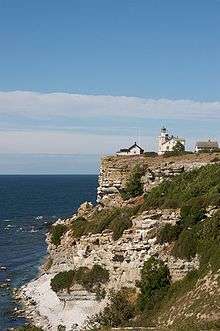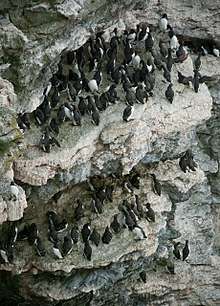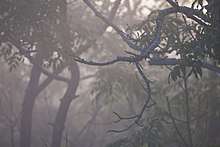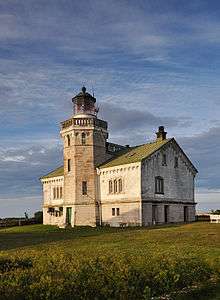Karlsöarna
Stora Karlsö and Lilla Karlsö (Swedish:"Large" and "Small" "Island of Carl", respectively) are two islands and natural reserves west of the Swedish island Gotland in the Baltic Sea. Stora Karlsö one of the oldest protected natural areas in the world, second only to Yellowstone National Park. The islands are also renowned for their rich birdlife.

Understand
History
The islands were created during the geological Silurian era some 400 million years ago, and mainly consists of limestone and old corals. The islands have been inhabited by humans at least since the stone age. During the middle ages the islands were used as marble quarries. Eventually the islands were mainly used for sheet grazing.
During the 19th century the islands were heavily used for fishing and hunting of the local birdlife, leading to the near depletion of the islands local colony of common murres. As a response to this the company Karlsö Jagt- och Djurskyddsförenings AB was founded in 1880 and successively bought the entire island, and thereby protecting it from hunters. It is the second oldest protected natural area in the world, second only to Yellowstone National Park. The island is still owned by Karlsö Jagt- och Djurskyddsförenings AB today.
In 1887 a lighthouse and a few permanent residences were built on Stora Karlsö, at its peak housing four families. As the islands became permanently inhabited by humans all sheep were removed from Stora Karlsö, while they remained on Lilla Karlsö. This created a natural experiment, as the impact of the grazing sheep on the biosphere of the islands could be studied and compared. Consequentially Lilla Karlsö has grown bare while Stora Karlsö is more overgrown, eventually leading to the reintroduction of sheep on Stora Karlsö in 1995. Lilla Karlsö is one of many destinations during Nils Holgersson's Journey Across Sweden.
Today there are no permanent residents on the islands.
Landscape
Stora Karlsö is 2.5 km2 (0.97 sq mi), and located some 6 km (3.7 mi) from the Gotland mainland. Lilla Karlsö is somewhat smaller at 1.6 km2 (0.62 sq mi), and located about 3 km (1.9 mi), west of Gotland. The distance between the islands is 4.5 km (2.8 mi). Since Stora Karlsö is about twice as far away from the Gutnish mainland as Lilla Karlsö, Lilla Karlsö appears larger than Stora Karlsö when seen from the mainland, contrary to their actual size and names. Both islands are limestone plateaus with steep cliffs along their shore lines. The porous rock is filled with several caves, some of them as deep as 20 m (66 ft).
Flora and fauna

Most of the islands are alvar, a form of prairie like grassland which thrives on limestone plains with little or no fertile soil. It is therefore home to a large number, such as Dactylorhiza sambucina and Orchis mascula. Other unusual flora include Adonis vernalis, Asplenium scolopendrium, Lactuca quercina (in Swedish called Karlsösallat) and Corydalis gotlandica, the only endemic species of Gotland. The main blossoming season is in May.
The islands attract large colonies of seabirds, and is the only proper "bird mountains" in the Baltic Sea. The most notable seabird colonies are common guillemots, black guillemots and razorbills. Notable predators include the Peregrine falcon and eagles. Since the bronze age the islands have been grazed by Gute sheep, the oldest sheep race in Sweden, and a common symbol of Gotland.
Climate
Get in
- See also: Boating on the Baltic Sea
During summer the islands can be reached by transportation boats from Klintehamn on the nearby Gotland mainland. The boat is operated by Karlsö Jagt- och Djurskyddsförenings AB and can be booked via +46-498-240500 boka@storakarlso.se. The ticket is 355 kr per person, which also includes a guided tour on the island. Crossing time to Stora Karlsö is 30 minutes. c
In May, June, and the latter part of August boats depart at 09:30 and 14:00 from the Klintehamn, and at 10:20 and 15:00 from Stora Karlsö. During the main season from late June to mid August boats depart from Klintehamn at 09:30, 11:30 (and 16:10 for those planning to stay overnight), and from Stora Karlsö at 10:20, 15:00 and 17:00. During the main season the same transportation boat also stops at Lilla Karlsö. The departures from Lilla Karlsö are set to 09:55 (continuing to Stora Karlsö) and 15:20 (continuing towards Klintehamn).
You can also travel to Stora Karlsö with your own sea vessel, and may land on the western side of the Norderhamn bridge. The fee for using the harbor is 150 kr per vessel and day, with an additional landing fee of 50 kr per person and day. If you plan to stay longer you can buy a 500 kr season ticket, covering harbor fee for one vessel and landing fee for two persons for one year. For 50 kr per day you also can get an electric wire to your vessel. The harbor supervisor can be reached via +46 498-241100 or +46 70-3237240.
Fees and permits
Entering the islands per se is free of charge. However, the only way to access them is by transportation boat, which is charged, or by your own vessel, which entails a harbor and landing fees (see section Get in for details). Most of the island's coast are off limits between March 15th and August 15th, in order to protect the local birdlife during their hatching season. The main exceptions are the western half of the northern coast of Stora Karlsö, and the South-Eastern shore of Lilla Karlsö.
On the islands it is not allowed to
- Bring pets
- Pick flora or fungi
- Pick or remove rocks and fossils
- Capture or harm fauna, including insects and spiders
- Carve or chisel rocks
- Make open fire, except for two designated grills found in Hien and Fyrbyn
- Camp
Get around
You will have to get by on foot, but considering that the largest island has a diameter of no more than 2 km (1.2 mi), there will be little need for any additional means of transportation. It is allowed to bring wheelchairs or strollers to the island, but as the paths across the islands are not paved it is not possible to access the entire islands with them.
See

One of the most spectacular natural events on Karlsöarna is "Grisslehoppningen", or "the leap of the guillemots". The young guillemots who are still unable to fly throw themselves from the high cliffs into the water below. The most intense period of guillemot leaping is by the end of June.
- Fossilmuseum (Lilla Karlsö). One of the few artificial sights on Lilla Karlsö is an exhibition with different fossils.
- Stora Karlsö Museum. Daily during season. Inaugurated in 1966, this museum deals with the local geological and human history, as well as the local flora and fauna.
- Stora Karlsö Lighthouse. Built in 1887 from rocks which were quarried from Stora Karlsö. It was automated in 1974, and is today listed. Those who stay on the island over night may also get a guided tour of the lighthouse.
Do
One of the most common activities on Stora Karlsö is the guided tour which is included in the shipping. The tour is some 2.5 km (1.6 mi) and takes some two and a half hours, meaning that the pace is very low with several stops along the way.
During the turn of the month between June and July many guillemots are marked for scientific purpose. It is possible to partake in the marking if permission is granted by the scientists on site. Participation is free, but is sometimes very popular. In order to minimize the disturbance of the birds only a limited number of persons can joint the expedition. There is therefore no guarantee that everyone who wants are allowed to participate.
Buy
- Kiosk. There is a kiosk by the restaurant in Norderhamn. They sell ice cream, candy, soda, books, maps souvenirs and the like. Note however that they, or anyone else on the islands for that matter, do not sell any groceries.
Eat
There is exactly one restaurant on Stora Karlsö, and none on Lilla Karlsö. Therefore, make sure that you bring sufficient provisions for the time you plan on staying.
- Broman Med Son (Norderhamn), ☎ +46 70-3027863, e-mail: restaurangen@storakarlso.se. Breakfast 08:00-09:00 (booked the evening before at the latest) Lunch 12:00-14:00 (booked on arrival to the island) Dinner 18:00-20:00 (can be booked until 17:00). They always has vegetarian options. In addition to the restaurant there is also a adjoined cafe and kiosk. Mains 230 kr.
Drink
Hot and cold drinks can be ordered in the restaurant and the cafe, or bought in the kiosk.
Sleep

Camping is not allowed on the islands.
- Fyrbyn (The Lighthouse Village), ☎ +46-498240500, e-mail: boka@storakarlso.se. Offer doubles and quadruples. The old houses surrounding the lighthouse, and rooms in the lighthouse itself, can be rented. There is a WC, shower and kitchen on the site, perhaps making it the more luxurious lodging alternative on the island. From 890 kr per room per night.
- Lilla Karlsön Strandstuga (Lilla Karlsön Beach Hut), ☎ +46 498-240500, e-mail: boka@lillakarlso.se. A small unmanned beach hut. There are basic cooking utilities by the cabin. There is however no serving on the island so make sure that you bring enough provisions yourself. 400 kr per night per person.
- Strandhuset (The Beach House) (Hien), ☎ +46-498240500, e-mail: boka@storakarlso.se. Offer doubles and quadruples. A newly constructed house, constructed in a traditional Gotland post-and-plank technique. There is a WC, shower and kitchen in connection to the rooms. From 1050 kr per room per night.
- Vandrarhemmet (The Hostel), ☎ +46-498240500, e-mail: boka@storakarlso.se. There are hostel lodgings scattered around Stora Karlsö, in Norderhamn, Hien and Bergshyddan. It was named hostel of the year in 2003 by the Swedish Tourist Association. Sheets must be brought or rented for an additional fee. Singles for 250 kr per night, doubles for 635 kr per night.
Stay safe
The islands, and particularly their coast lines, are filled with steep cliffs and rocks. These are especially slippery and should be avoided during rainy weather.
Go next
If you arrived by the transport boat the only place to go is back the way that you came from. On the other hand, if you arrived by your own vessel you have an ocean of opportunities.